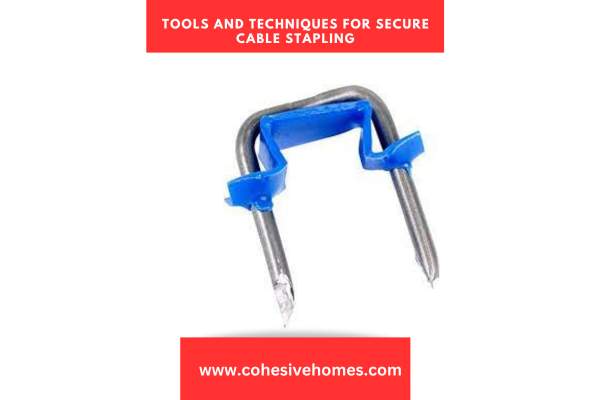When it comes to electrical installations and wiring projects, it’s crucial to adhere to the highest standards of safety and efficiency. Among the various aspects of electrical work, securing the wiring with the right number of staples is essential for maintaining a well-organized and hazard-free environment. If you’ve ever wondered how many Romex cables should be fastened with a single staple, you’ve come to the right place.
In this blog post, we will delve into the important considerations and guidelines for determining the appropriate number of Romex cables per staple.
Whether you’re a seasoned electrician looking for a refresher or a DIY enthusiast embarking on your first electrical project, understanding this crucial aspect will help you ensure a secure and reliable wiring installation.
The Importance of Properly Securing Romex Cables

Properly securing Romex cables is of utmost importance in electrical installations.
By securely fastening the cables with appropriate staples, you ensure that they are neatly organized and protected from damage or accidental dislodgment.
This helps maintain the integrity of the wiring system, reducing the risk of short circuits, electrical malfunctions, and potential hazards such as electrical shocks or fires.
Additionally, neatly secured cables make it easier to identify and troubleshoot any issues that may arise in the future, saving valuable time and effort.
Potential Risks of Improper Stapling

Improper stapling of Romex cables can lead to a range of potential risks and safety hazards.
If cables are not adequately secured, they may hang loosely or come into contact with sharp objects, leading to abrasion or insulation damage.
This can expose live wires, increasing the likelihood of electrical shocks or short circuits.
Loose cables may also become entangled or snagged, causing strain on the connections and increasing the risk of cable failure over time.
Furthermore, dislodged or loosely secured cables may create a cluttered and disorganized environment, making it difficult to identify and access specific wires for maintenance or repairs.
Industry Standards and Best Practices

To ensure safe and efficient electrical installations, industry standards and best practices have been established regarding the stapling of Romex cables.
The National Electrical Code (NEC) provides guidelines for cable securing, including the maximum spacing between staples and the recommended number of cables per staple.
These standards aim to maintain the structural integrity of the wiring system, prevent cable damage, and reduce the risk of electrical hazards.
Adhering to these standards not only ensures compliance with regulations but also enhances the overall safety and reliability of the electrical installation.
Factors to Consider When Determining the Number of Romex Cables per Staple

Several factors come into play when determining the appropriate number of Romex cables to be secured with a single staple.
These factors include the cable gauge, the number of conductors within the cable, the size and type of staple being used, and the specific requirements outlined in the NEC or local electrical codes.
Generally, for smaller gauge cables with fewer conductors, it is common to staple a single cable per staple.
However, for larger gauge cables or when dealing with multiple cables, guidelines may recommend using additional staples to ensure proper support and organization.
It’s important to note that these guidelines are meant to provide a general framework, and local regulations or specific project requirements may have additional considerations.
Consulting the NEC and local electrical codes, as well as seeking guidance from professionals or inspectors, can help ensure compliance and optimal safety in cable stapling practices.
Understanding Stapling Guidelines for Different Situations

Stapling guidelines for Romex cables can vary depending on the specific situation and application.
For instance, when running cables along framing members, such as studs or joists, it is common to staple the cables within 8 inches of boxes, and then at intervals of 4.5 feet or less thereafter.
This ensures that the cables are adequately supported and secured along their entire length.
In areas where cables pass through bored holes, notches, or conduit, additional staples may be required to maintain proper positioning and prevent excessive movement.
In situations where multiple cables are run parallel to each other, it is important to maintain spacing between the cables and avoid overcrowding.
This helps to prevent overheating and ensures that the cables can dissipate heat properly.
Generally, it is recommended to use separate staples for each cable, although local codes or project specifications may dictate alternative guidelines.
Tools and Techniques for Secure Cable Stapling

To ensure secure and reliable cable stapling, it is essential to use the appropriate tools and techniques.
Cable staples, typically made of durable materials such as steel, are specifically designed to secure Romex cables.
These staples come in various sizes and types, including plastic-coated or insulated options for added protection against damage or abrasion.
When stapling cables, it is crucial to use a staple gun or stapler that is compatible with the size and type of staples being used.
This helps to ensure proper penetration and secure attachment.
Care should be taken to avoid overdriving or underdriving the staples, as both can lead to potential cable damage or inadequate support.
Another important technique is to position the staple correctly.
Staples should be placed in such a way that they do not pierce or compress the cables excessively.
Proper positioning ensures that the cables are securely held in place without compromising their integrity or insulation.
Safety Considerations for Electrical Projects

Safety should always be the top priority when working with electrical projects.
Before beginning any electrical installation or wiring work, it is important to disconnect power sources and take necessary precautions to prevent electrical shock.
Additionally, using personal protective equipment (PPE), such as gloves and safety glasses, can provide an extra layer of protection.
Furthermore, it is crucial to be aware of any potential hazards in the work area, such as existing electrical wiring, plumbing, or structural elements.
Careful planning, thorough inspections, and compliance with safety regulations and codes are essential to minimize risks and create a safe working environment.
Conclusion

Properly securing Romex cables with the appropriate number of staples is essential for safe and reliable electrical installations.
By adhering to industry standards, understanding the guidelines, and employing best practices, you can ensure that your wiring projects are organized, protected, and compliant with regulations.
Remember to consider factors such as cable gauge, number of conductors, staple spacing, and local codes to determine the ideal number of Romex cables per staple.
Always prioritize safety, use the right tools and techniques, and avoid common mistakes to create a secure and efficient wiring system.
Whether you’re an experienced electrician or a DIY enthusiast, following these guidelines will help you achieve professional-grade results and provide peace of mind knowing that your electrical installations are built on a foundation of safety and reliability
